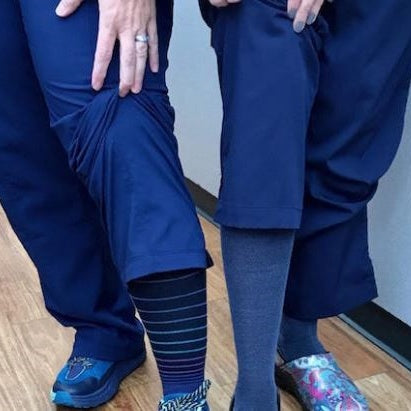
Compression Socks are Revolutionizing Comfort and Circulation in Healthcare
Share
Compression socks have become a staple in the healthcare industry, offering remarkable benefits in terms of comfort and circulation. This article explores the significance of compression socks and their transformative impact on the well-being of patients and healthcare professionals in various healthcare settings.
Enhanced Circulation and Blood Flow:
Compression socks exert gentle pressure on the legs, effectively improving blood circulation. The graduated compression design applies the highest pressure at the ankles and gradually decreases towards the calves. This helps prevent blood pooling, reduces swelling, and enhances the flow of oxygen and nutrients to the muscles, promoting overall circulatory health.
Prevention of Deep Vein Thrombosis (DVT):
Deep Vein Thrombosis is a serious concern in healthcare, particularly for patients who are immobile or undergoing surgeries. Compression socks provide vital support in the prevention of DVT by promoting blood flow and reducing the risk of blood clots. This proactive measure significantly contributes to the safety and well-being of patients during their healthcare journey.
Reduction of Leg Fatigue and Discomfort:
Healthcare professionals often spend long hours on their feet, which can lead to leg fatigue and discomfort. Compression socks provide targeted compression, helping to reduce muscle fatigue, aching, and cramping. By providing support to the leg muscles, these socks enhance endurance and comfort, allowing healthcare professionals to focus on delivering quality care.
Improved Energy and Performance:
The improved circulation facilitated by compression socks contributes to increased energy levels and improved performance. Patients and healthcare professionals who wear compression socks often experience enhanced stamina, reduced muscle soreness, and improved overall mobility. This enhances productivity, enabling individuals to fulfill their responsibilities with greater ease.
Versatility and Style:
Compression socks are available in a wide variety of styles, colors, and patterns, catering to the individual's preferences and personal style. This versatility enables patients and healthcare professionals to seamlessly incorporate compression socks into their wardrobes, promoting both comfort and aesthetic appeal.
Post-Surgical Recovery and Wound Healing:
Compression socks play a vital role in post-surgical recovery and wound healing. These socks provide gentle compression, helping to reduce post-operative swelling and promote healing in the affected areas. By enhancing blood circulation, compression socks help prevent complications and contribute to faster recovery times.
Conclusion:
Compression socks have revolutionized comfort and circulation in healthcare, benefiting both patients and healthcare professionals. Through enhanced circulation, the prevention of deep vein thrombosis (DVT), reduced leg fatigue, improved energy, and increased mobility, compression socks significantly contribute to the well-being and performance of individuals in healthcare settings. Embracing the remarkable benefits of compression socks can lead to improved patient outcomes, increased comfort for healthcare professionals, and a more supportive and productive healthcare environment overall.
